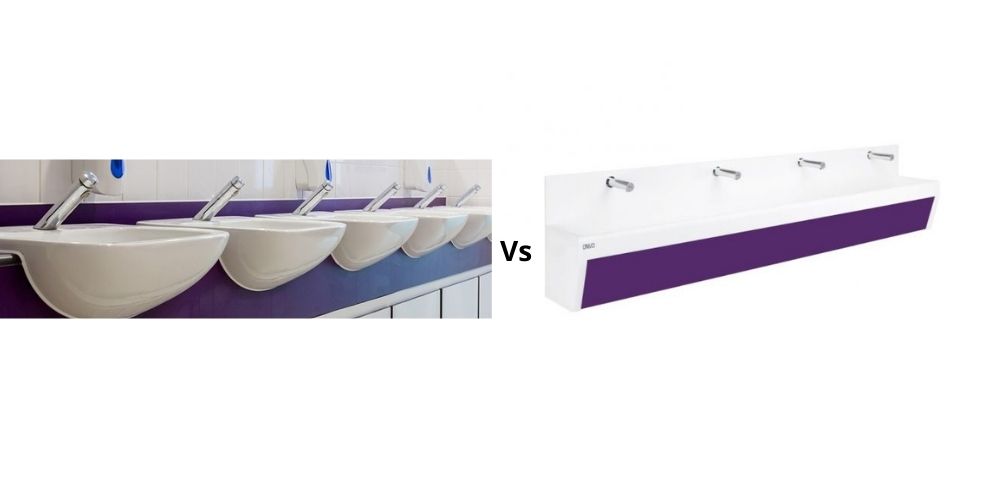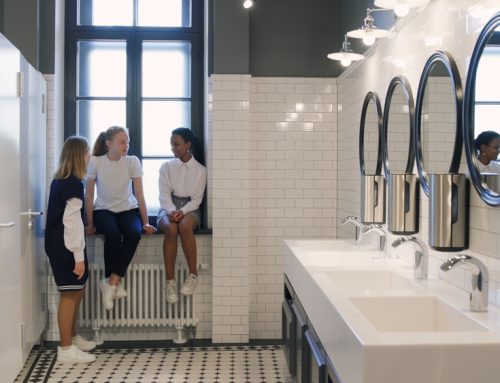Hands carry an average of 3200 different germs, many of which can cause serious infection and illness.
Even without the grim statistics, most of us understand the importance of regular handwashing. Yet the simple fact is, it’s not just how often hands are washed but how well and when.
Before eating and after using the toilet are some of the most obvious times. But other factors – such as the type of work you do and access to amenities – impact handwashing frequency and efficiency.
Important then, to make sure your business provides ample clean and user-friendly facilities.
Two of the most popular ways to do this? Vanity units and wash troughs. But what are the real differences between these options and how do you know which is right for your setting?
To help, washroom specialist, ONVO, take a closer look here at the pros and cons of each handwashing solution.
Vanity units
Pros
- One of – if not the – biggest draw to a vanity unit is the ability to hide pipework. By using smart panelling, wires, drainage pipes and other important elements such as heaters and thermostatic mixing valves, can all be discreetly tucked out of sight and kept out of harm’s way.
- Available in a wide choice of finishes and materials, vanity units make it easy to customise the look and feel of your washroom. You can even match units, so they perfectly complement toilet cubicles for a smart, professional finish.
- With the freedom to choose your materials, you gain greater control of price and can adapt the materials used to suit your requirements and budget. Typically, this makes vanity units a slightly cheaper option.
- Relatively simple to design and manufacture, vanity units are readily available from just about any washroom company.
Cons
- Vanity units may hide pipework, but they can be difficult to keep clean. With a larger expanse of worktop, panelling, and silicon joints between basins to sanitise, it can be an arduous and time-consuming task.
- The perk of the vanity unit is undoubtedly covering unsightly pipework. However, by hiding the pipes and wires, it’s important to keep in mind that you are also restricting access.
- The vanity unit itself is usually made from wood or other wood-like products (such as HPL – high pressure laminate). Easy to work with, yes, but not ideally suited to a damp washroom environment. Vanities have flat areas between the basins where water easily accumulates, and within a comparatively short space of time, these materials will absorb moisture and start to break down.
- With inset ceramic basins comes the need for silicone joints. Unfortunately, these quickly discolour and start to look dirty – and as the appearance degrades, so too does the sealant quality.
Wash troughs
Pros
- When it comes to maximising hygiene levels few options can rival the wash trough. With taps mounted to the deck of the wash trough, there’s no void required behind. This, combined with the fact that splashbacks are coved, helps to prevent dirt traps and reduce areas that could harbour germs and bacteria.
- By design, wash troughs are sleek and streamlined. This not only means they look good – they’re quick and easy to keep clean too. And if you’re short on space, you’ll find the dimensions usually take up less space than a vanity unit.
- Pipework and wires you need to hide? Wash troughs can be paired with modular frame systems to protect and conceal pipes and wires – whilst still providing quick and easy access for maintenance.
- By replacing individual sinks with one long narrow basin, wash troughs make it considerably easier to accommodate multiple users and maximise space. It also eliminates the need for silicone joints.
- Highly customisable, not only can wash troughs be made to bespoke lengths, there’s a choice of widths and a vast range of surface and front panel colour choices too. Meaning you can create a hand washing area that is entirely in-keeping with its surroundings. You even have the option to move taps closer together – great for settings with younger children – enabling more handwashing points within a smaller space.
- The design of wash troughs is borne from a need to provide modern, functional, and durable hand washing facilities. As one long sink with a single drainage outlet, they are quick to install, easy to maintain, and less prone to damage and flooding. Worth noting too, that any damage to a Corian surface can be removed using 180G abrasive paper. Simply rub in a circular motion over the affected area – not so easy with a standard porcelain basin!
- Robust design, combined with reduced cleaning and maintenance demands, make wash troughs a long-lasting and cost-effective solution.
Cons
As providers of premier wash trough sinks for schools and healthcare settings, we may be a little biased, but when it comes to the downsides of this type of handwashing solution, we’re genuinely struggling to think of any.
Possible drawbacks include:
- Corian or other solid surface brands are often the favoured material for wash troughs. Offering a strong durable surface that is hardy to damage (so much so that here at ONVO we offer a 10-year guarantee on our Corian wash troughs). However, care must always be taken as very strong acids or strong chlorinated solvents can cause surface damage, spots or staining.
- The initial outlay for wash troughs can be more expensive (they tend to be approximately 20% more than a vanity unit). However, this is easily offset by their impressive product life cycle.
And the winner is?
When it comes to deciding between vanity units and wash troughs, the right option will largely come down to individual need, preference and budget. But if you require a long-lasting, attractive, and modern solution, we firmly believe you’ll be hard pushed to better a wash trough.
Read enough and primed to order, or keen to discuss your project in more detail? Either way, the team at ONVO are here to help. With vast experience supplying quality washroom fittings, we’re on hand and ready to help.
Visit our contact page to request a call back or email us at sales@onvouk.com and we’ll be in touch.





Leave A Comment